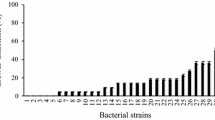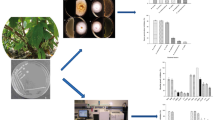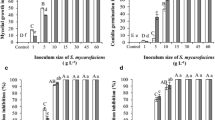Abstract
Volatile compounds generated from Streptomyces philanthi RM-1-138 grown on autoclaved wheat seeds for seven or 14 days suppressed the growth of four plant pathogenic fungi (Rhizoctonia solani PTRRC-9, Pyricularia grisea PTRRC-18, Bipolaris oryzae PTRRC-36 and Fusarium fujikuroi PTRRC-16). The inhibition was most pronounced on R. solani PTRRC-9 while the least inhibition was against F. fujikuroi PTRRC-16. The volatile compounds from 14 days old cultures exhibited a stronger inhibitory effect (52.85–100 %) on the four fungal strains than those from the 7 days old cultures (17.03–89.40 %). Identification of the volatile organic compounds produced by Streptomyces philanthi RM-1-138 using gas chromatography–mass spectrometry (GC–MS) revealed 17 and 36 compounds from the seven days old and 14 days old cultures, respectively. They could be chemically grouped into alcohols, alkenes, aromatic hydrocarbons, sulfides, ketones, ester and alkanes, some of which were known antimicrobial agents. Among them, the most abundant volatile component was 3,7-dimethylocta-1,6-dien-3-ol (l-linalool). Effect of the inoculum size and spore concentration of S. philanthi RM-1-138 prepared as a wheat seed inoculum on the suppression of R. solani PTRRC-9 was studied. Total inhibition of growth (100 %) was achieved using an inoculum size of at least 15 g l−1 and a spore concentration of 1 × 107 spore ml−1, respectively. Consistent (closed container) transfer of volatile substances from S. philanthi RM-1-138 to healthy tissues of rice leaves effectively reduced the incidence and/or the severity of sheath blight disease caused by mycelium or sclerotia. The cell wall of R. solani PTRRC-9 showed damage as observed by a scanning electron microscope (SEM) and a transmission electron microscope (TEM). The results indicated that the volatile compounds from S. philanthi RM-1-138 could effectively control the rice sheath blight disease caused by R. solani PTRRC-9.



Similar content being viewed by others

References
Arrebola E, Sivakumar D, Korsten L (2010) Effect of volatile compounds produced by Bacillus strains on postharvest decay in citrus. Biol Control 53:122–128
Boukaew S, Chuenchit S, Petcharat V (2011) Evaluation of Streptomyces spp. for biological control of Sclerotium root and stem rot and Ralstonia wilt of chili pepper. BioControl 56:365–374
Brimner TA, Boland GJ (2003) A review of the non-target effects of fungi used to biologically control plant diseases. Agric Ecosyst Environ 100:3–16
Bruce A, Stewart D, Verrall S, Wheatley RE (2003) Effect of volatiles from bacteria and yeast on the growth and pigmentation of sapstain fungi. Int Biodeter Biodegr 51:101–108
Chen H, Xiao X, Wang J, Wu L, Zheng Z, Yu Z (2008) Antagonistic effects of volatiles generated by Bacillus subtilis on spore germination and hyphal growth of the plant pathogen, Botrytis cinerea. Biotechnol Lett 30:919–923
Corcuff R, Mercier J, Tweddell R, Arul J (2011) Effect of water activity on the production of volatile organic compounds by Muscodor albus and their effect on three pathogens in stored potato. Fungal Biol 115:220–227
Dickschat JS, Martens T, Brinkhoff T, Simon M, Schulz S (2005) Volatiles released by a Streptomyces species isolated from the North Sea. Chem Biodivers 2:837–865
Gu YQ, Mo MH, Zhou JP, Zou CS, Zhang KQ (2007) Evaluation and identification of potential organic nematicidal volatiles from soil bacteria. Soil Biol Biochem 39:2567–2575
Huang R, Li GQ, Zhang J, Yang L, Che HJ, Jiang DH, Huang HC (2011) Control of postharvest Botrytis fruit rot of strawberry by volatile organic compounds of Candida intermedia. Dis Control Pest Manag 101:859–869
IRRI (1993) Field problems of tropical rice. International Rice Research Institute, Philippines
Kang ZS, Huang LL, Krieg U, Mauler-Machnik A, Buchenauer H (2001) Effects of tebuconazole on morphology, structure, cell wall components and trichothecene production of Fusarium culmorum in vitro. Pest Manag Sci 57:491–500
Kanjanamaneesathian M, Kusenwiriyawong C, Pengnoo A, Nilratana L (1998) Screening of potential bacterial antagonists for control of sheath blight in rice and development of suitable bacterial formulations for effective application. Australasian Plant Pathol 27:198–206
Li Q, Ning P, Zheng L, Huang J, Li G, Hsiang T (2010) Fumigant activity of volatiles of Streptomyces globisporus JK-1 against Penicillium italicum on Citrus microcarpa. Postharvest Biol Technol 58:157–165
Li Q, Ning P, Zheng L, Huang J, Li G, Hsiang T (2012) Effects of volatile substances of Streptomyces globisporus JK-1 on control of Botrytis cinerea on tomato fruit. Biol Control 61:113–120
Mendgen K, Schiewe A, Falponi C (1992) Biological control of plant diseases. Belchim Crop Protect 45:5–20
Ou SH (1987) Rice Diseases, 2nd edn. International Rice Research Institute, Los Banos, Philippines
Prapagdee B, Kuekulvong C, Mongkolsuk S (2008) Antifungal potential of extracellular metabolites produced by Streptomyces hygroscopicus against phytopathogenic fungi. Int J Biol Sci 4:330–337
Romero D, Vicente A, Olmos JL, Davila JC, Perez-Garcia A (2007) Effect of lipopeptides of antagonistic strains of Bacillus subtilis on the morphology and ultrastructure of the cucurbit fungal pathogen Podosphaera fusca. J Appl Microbiol 103:969–976
Ross ZM, Gara EA, Hill DJ, Sleightholme HV, Maslin DJ (2001) Antimicrobial properties of garlic oil against human enteric bacteria: evaluation of methodologies and comparisons with garlic oil sulfides and garlic powder. Appl Environ Microbiol 67:475–480
Roze LV, Beaudry RM, Arthur AE, Calvo AE, Linz AE (2007) Aspergillus volatiles regulate aflatoxin synthesis and asexual sporulation in Aspergillus parasiticus. Appl Environ Microbiol 73:7268–7276
Ryu CM, Farag MA, Hu CH, Reddy MS, Wei HX, Pare PW, Kloepper JW (2003) Bacterial volatiles promote growth in Arabidopsis. Proc Natl Acad Sci USA 100:4927–4932
Ryu CM, Farag MA, Hu CH, Reddy MS, Kloepper JW, Pare PW (2004) Bacterial volatiles induce systemic resistance in Arabidopsis. Plant Physiol 134:1017–1026
Vespermann A, Kai M, Piechulla B (2007) Rhizobacterial volatiles affect the growth of fungi and Arabidopsis thaliana. Appl Environ Microbiol 73:5639–5641
Walter MY, Crawford DL (1995) Characterization of Streptomyces lydicus WYEC108 as a potential biocontrol agent against fungal root and seed rots. Appl Environ Microbiol 61:3119–3128
Wan M, Li G, Zhang J, Jiang D, Huang HC (2008) Effect of volatile substances of Streptomyces platensis F-1 on control of plant fungal diseases. Biol Control 46:552–559
Wilkins K (1996) Volatile metabolites from Actinomycetes. Chemosphere 32:1427–1434
Acknowledgments
This work was financially supported by a scholarship from the Office of the Higher Education Commission to Mr. Sawai Boukaew under the CHE- PhD Scholarship Program, the Higher Research Promotion and National Research University Project of Thailand, and Graduate School of Prince of Songkla University. Thank to Associate Professor Dr. Vasun Petcharat at National Biological Control Research Center Southern Regional Center for providing the Streptomyces philanthi RM-1-138 used in this study. The authors thank Professor Dr. Brian Hodgson for proof-reading the manuscript.
Author information
Authors and Affiliations
Corresponding author
Additional information
Handling Editor: Jesus Mercado Blanco
Rights and permissions
About this article
Cite this article
Boukaew, S., Plubrukam, A. & Prasertsan, P. Effect of volatile substances from Streptomyces philanthi RM-1-138 on growth of Rhizoctonia solani on rice leaf. BioControl 58, 471–482 (2013). https://doi.org/10.1007/s10526-013-9510-6
Received:
Accepted:
Published:
Issue Date:
DOI: https://doi.org/10.1007/s10526-013-9510-6



